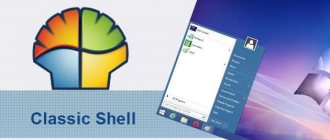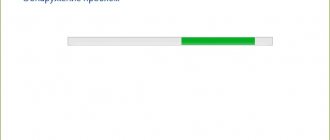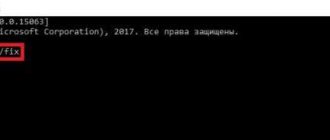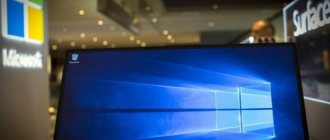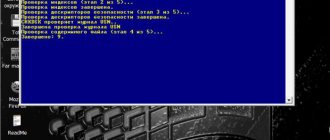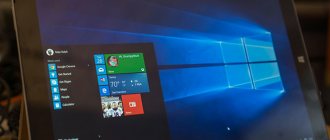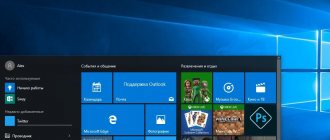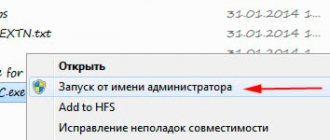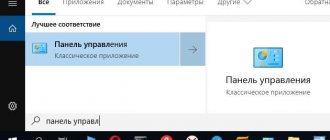Classic Shell is a free program for returning the classic Start menu to its previous appearance in the operating systems Windows 10, Windows 8.1, Windows 8, Windows 7, Windows Vista. The program changes the visual display of elements of the Windows operating system for more convenient use.
Many users experience inconvenience when using the Start menu due to the fact that the Windows developer, Microsoft, constantly changes the settings, options and appearance of the Start menu.
Therefore, many users want to return the classic Start menu for the operating systems Windows 10, Windows 8.1, Windows 8. In the Windows 7 operating system, users change the appearance of the Start menu in the style of the Windows XP operating system.
The free Classic Shell program returns the classic look of the Start menu and allows you to make extensive settings for the display of styles, options and design of the start menu.
The Classic Shell program consists of three components:
- Classic Start Menu - The return of the classic Start menu.
- Classic Explorer - Add a toolbar to Windows Explorer.
- Classic IE - customizing panels in the Internet Explorer browser.
In this article we will look at the operation of the Classic Start Menu component, which allows you to create the old Start menu in the Windows operating system. Not all users need other program components.
The Classic Shell program works in Russian. You can download the Classic Shell program from the official website of the developer. On the downloads page, select the “Classic Shell xxx (Russian)” file to download to your computer.
Classic Shell download
About the program
The main goal of the Classic Shell program is to modify the Start Menu with the ability to edit it to suit your needs, as well as introduce additional functions into Explorer. In general, it allows you to:
- Customize your Start menu with several templates.
- Modify start buttons for Windows 7, 8, 10.
- Search files and documents.
- Get quick access to frequently used programs.
- Flexibly customize the Start menu to suit your needs.
The program also adds additional functions to Explorer, such as “status bar” and “toolbar”.
The utility is in English (with the possibility of updating to the Russian version), distributed free of charge. You can download it from the official website of the developer. Installation is straightforward.
How to work with the utility?
Before you start, you need to download the program. The distribution is publicly available on the developer's official website. Classic Shell is compatible with Windows 10, 8, 7 and includes three components:
- Classic Explorer. Adds a toolbar and status bar to File Explorer.
- Classic Start Menu. Adds a Start button and a traditional menu.
- Classic IE9. Adds a title bar and status bar for Internet Explorer.
After the installation of Classic Shell is complete, a window will open asking you to customize the appearance, Start menu styles, and add hotkeys. You can choose which items appear in the menu, enable new features, and even change the appearance of the button itself to your favorite image in .bmp and .png format.
Settings and features
After installation is complete, a window with styles will appear:
- In the first tab, you can choose the style in which your Start menu will be designed. There are three options in total: classic, classic with two columns and Windows 7 style.
- The second tab allows you to further configure hotkey commands.
- On the third tab, you can select the skin you like to design the Start menu.
- The fourth tab offers personal settings for the Start menu. Here you can set which elements and how will be displayed in the Start menu.
- If you check the box next to “Show all Setting”, 10 more tabs will open, which allow you to flexibly customize the menu design and adjust the available functions.
Advice! If you are not comfortable with the English interface of the program, you can install the Russian language. To do this, open the “Language” tab, select “Ru” and click “Click here to install it”. Then close the panel and launch Setting for Classic Start Menu.
Now, here are some examples of quick customization of the Windows 10 Start menu:
- Windows 7 Style → Classic Skin.
- Classic Style → Metro.
- Classic with two columns → Windows XP Luna.
- Windows 7 Style → Metallic.
You can modify the Start button itself. Click the “Replace Start button” and select two proposed options, or attach your own. The program only works with .bmp and .png formats.
Getting started and list of important CMD commands
There are several ways to get to the command line. It all depends on the version of the installed operating system. To get started with Command Shell in Windows XP, you need to find Run in the Start menu and type cmd.exe. In later versions, just press Win + R.
The total number of cmd commands is about 280, the number varies depending on the version. To see the entire list, you need to go to the console, enter help and press Enter. There is no point in remembering them for the average user. We invite you to get acquainted with the most necessary commands that will be useful in your work everywhere.
Main features of Classic Shell for Windows 8, 10:
- Returns the standard Start menu view;
- Returns the cascading architecture of submenus in the Windows main menu;
- Returns the familiar appearance of the Internet Explorer browser using a plugin;
- Skin support for changing themes;
- Compatible with all versions of Windows;
- Russian language support;
- Does not put a strain on system resources, has minimal system requirements.
Please note that the Classic Shell program will return the Start button and menu to you only in Windows 10 and 8. There is no point in installing Classic Shell for Window 7, it already has a Start menu.
The Windows 10 Start menu is inconvenient for many users - firstly, everyone is accustomed to its classic appearance, as it was in XP and 7 (some even found it in previous versions of the operating system 95-98).
And secondly, developers have recently been changing its appearance and parameters in every possible way. If you are one of those users who are conservative in this matter, or simply want to regain their previous ease of use, and want the Windows 10 Start menu to become like in 7
..., - this article is for you!
Text interface and command line
A text-based user interface is fundamentally different from a graphical one. It's much more difficult to work with. All information is presented in the form of special characters, letters and numbers, rather than simple and understandable windows. But TUI is much less demanding on computer resources, and programs with a text interface launch faster and run on low-power hardware.
The part of the Windows Shell that allows you to control your computer through interactive command input is called the command interpreter. There are two types of interpreters for the Windows operating system. The first is cmd.exe, or command line, the second is PowerShell.
In appearance, the command line largely resembles MS-DOS. Control is carried out entirely by typing and entering alphanumeric instructions. It is for this reason that the command line is considered the exclusive domain of programmers and system administrators. Beginners consider it something mysterious and incomprehensible.
But the command line ensures fast execution of computer tasks, instant search and launch of programs. When the system is infected with a virus, the graphical interface is completely blocked or freezes. In such a situation, access to files is possible only through the command interpreter.
Classic Shell for Windows 10
After the program is downloaded to your computer, we will install it, during which you need to disable unnecessary components. As I wrote above, we need Classic Start Menu. And it wouldn’t hurt to leave the program automatically updated.
You can immediately notice that starting Windows 10
has changed dramatically. Now you need to select the so-called cover or leave the standard one installed by the developers.
It is worth noting that changes can be made at any time. To do this, you need to use the “Settings” item by right-clicking on the menu.
Go to “Style” -> “Basic Settings” -> “Cover” -> “Settings” and make the required changes.
Personally, I always use the middle option, the so-called “Classic with two columns”. You can use more suitable ones for yourself.
By and large, the application is initially configured optimally for the user. Therefore, making any changes other than the appearance of the menu for an ordinary user is unnecessary.
How to remove Classic Shell
You can uninstall in many ways, for example, using CCleaner or standard Windows utilities. Personally, I prefer to use the Uninstall Tool. It not only removes programs from your computer, but also automatically scans systems for residual files and registry entries.
Of course, this utility is not the only one, there are many of them, for example...
Bringing back the Start button and menu in Windows 8.1 and 10
- Wentutu Windows8 Start Menu
– wentutu.com - StartIsBack
- www.startisback.com - Start Menu X
- www.startmenux.com/ru - Convenient menu
- www.handystartmenu.com/rus - Start 8
- www.stardock.com/products/start8 - Classic Shell
- www.classicshell.net - Spesoft Free Windows 8 Start Menu
- www.spesoft.com/free-windows-8-start-menu.aspx - Power 8
- //code.google.com/archive/p/power8 - ViStart 8
— increaseblog.ru/obzor-programm/kak-vernut-knopku-pusk-windows-8.html - Win8StartButton
- www.cdmail.ru/sys/utilities/win8startbutton.html - StartMenu8
- www.startmenu8.com/ru/index.html
That's all. I hope you liked the article and like it.
In turn, I want to ask you, what utilities do you use? Please write your answers in the comments. Thank you!
Classic Shell is a free program for returning the classic Start menu to its previous appearance in the operating systems Windows 10, Windows 8.1, Windows 8, Windows 7, Windows Vista. The program changes the visual display of elements of the Windows operating system for more convenient use.
Many users experience inconvenience when using the Start menu due to the fact that the Windows developer, Microsoft, constantly changes the settings, options and appearance of the Start menu.
Therefore, many users want to return the classic Start menu for the operating systems Windows 10, Windows 8.1, Windows 8. In the Windows 7 operating system, users change the appearance of the Start menu in the style of the Windows XP operating system.
The free Classic Shell program returns the classic look of the Start menu and allows you to make extensive settings for the display of styles, options and design of the start menu.
The Classic Shell program consists of three components:
- Classic Start Menu - return of the classic Start menu
- Classic Explorer - Add a toolbar to Windows Explorer
- Classic IE - customizing panels in Internet Explorer
In this article we will look at the operation of the Classic Start Menu component, which allows you to create the old Start menu in the Windows operating system. Not all users need other program components.
The Classic Shell program works in Russian. You can download the Classic Shell program from the official website of the developer. On the downloads page, select the “Classic Shell xxx (Russian)” file to download to your computer.
classic shell download
Method without installing software
The first option is applicable only for the latest version – Windows 10.
- You need to open the standard Start menu for this version.
- Next, you need to right-click on each application tile located on the right side of the menu and select the “Unpin from Start” function, or a similar one when using another language, as shown in the screenshot. This will eliminate all tiles.
- After this, the Start menu will roughly resemble the one used in Windows 7.
However, this option will not be fully functional, and users want to use an option identical to that used in previous versions.
Installing Classic Shell
Installation of the Classic Shell program occurs in Russian and does not cause any difficulties. Go through the Classic Shell installation wizard one by one.
In the Custom Installation window, you must select application components to install on your computer. By default, all components are selected for installation.
We want to bring back the classic Start menu, so we only need to keep the “Classic Start Menu” and “Classic Shell Update” components (for automatic updates).
The "Classic Explorer" and "Classic IE" components change the appearance of Explorer and Internet Explorer, respectively, and not all users need such changes. Therefore, disable the installation of these components.
Setting up Classic Shell
After installing the application, the “Classic Start Menu Options” window will open. In this window, all program parameters are configured.
You can change Classic Shell settings at any time. To do this, right-click on the “Start” menu and select “Settings” in the context menu.
In the “Start Menu Style” tab, you can select a classic style for the Start menu in the style of the Windows XP or Windows 7 operating systems.
With default settings, the standard Start button is displayed on the Desktop. Instead of the button image from the operating system, you can set the image from Classic Shell (two options) or add your own image if you have a similar image.
By default, the main settings in the program are made in the tabs: “Start Menu Style”, “Basic Settings”, Cover”, “Start Menu Customization”.
Check the box next to “Show all parameters” to configure other parameters in the Classic Shell program.
After this, additional settings will become available in the tabs: “Menu View”, “Start Button”, “Taskbar”, “Windows 10 Settings”, “Context Menu”, “Sounds”, “Language”, “Control”, “Home” menu", "General behavior", "Search field".
Although the program is configured optimally by default, the user can independently change the application settings to suit his needs by experimenting with the settings. To do this, select the settings, see what happened after changing them. If it turns out that you went a little overboard with the settings changes, you can return the program settings to their defaults.
In the application settings, you can hide unnecessary functions, change the display of elements and icons, change the order of elements, and remove elements from the Start menu.
To do this, select the element, select a command and display. After right-clicking on the desired element, select additional functions.
In the “Skin” tab, you can select a cover for the standard “Start” menu. By default, Windows 10 uses the Metro skin. You can choose from other skins: Windows Aero, Metallic, Midnight or Windows 8, a minimalist Classic Skin or No Skin.
Classic Shell parameter settings can be saved to an XML file in order to load the settings from this file during a new installation of the Classic Shell program. To do this, use the “Archive parameters” button, select the desired option: “Save to an XML file” or “Load from an XML file”. To reset the program's settings to default, select "Reset all settings."
System File Checker
The SFC command is designed to check the OS file system. It finds damaged “broken” files and replaces them without direct user intervention. This is an indispensable tool for system recovery and the best antidote to BSOD - the “screen of death”.
- sfc /scannow – immediately performs a scan with automatic file replacement;
- /scanonce – the scan will be launched at the next restart;
- /scanboot – automatic scan at every restart; to cancel it, enter sfc Revert in the Windows Shell command line;
- /verifyonly – verification without corrections;
You can run the program only with administrator rights. To do this, before starting work, you need to go to “user accounts” and uncheck the “disable administrator rights” checkbox.
